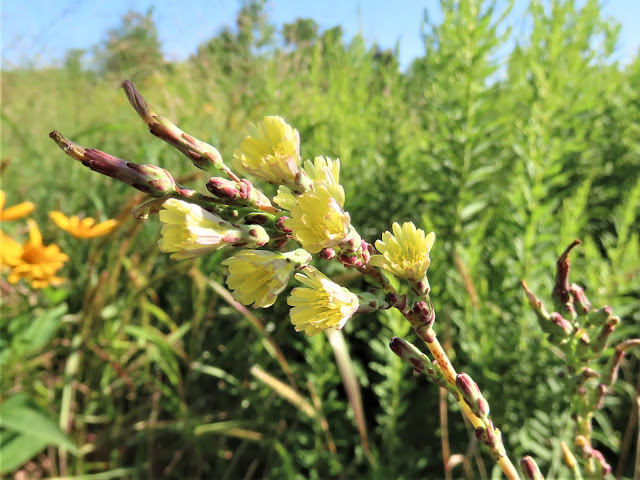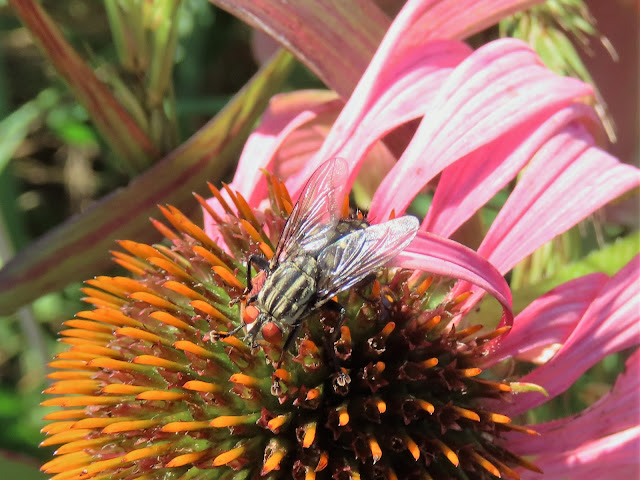09 August 2021
Our backyard, Waterloo, ON
Northern Cardinals (Cardinalis cardinalis) are daily visitors to our backyard, and this handsome male makes a statement!
You could be forgiven for thinking that he looks a little grumpy, but a couple of minutes later he was singing his head off! A male House Finch (Haemorhous mexicanus) is a smart looking bird too.
A female Cabbage White (Pieris rapae) would find it hard to compete with the cardinal or the finch in the good-looks department, but she is a welcome visitor nonetheless.
I have tried as best I can to identify this arachnid, without success. If you know what it is, feel free to leave a comment.
Our backyard, Waterloo, ON
Chipping Sparrow (Spizella passerina) is a frequent victim of cowbird parasitism and in years past we have seen these tiny birds feeding gargantuan cowbirds. This year, however, we have on several occasions observed adults feeding their own young, so perhaps they are developing effective strategies to combat the cowbird cheats.
These two are gazing skyward for some reason.
They did not appear alarmed and we saw no predator in the sky above them, so what they were looking at will forever remain a mystery. A third individual was perched nearby.
The following American Robin (Turdus migratorius) is probably a female, based on the muted colouration.
Females are generally duller overall with browner black on the head, but I have never found this to be entirely reliable, and somewhat subjective. For all practical purposes males and females look the same. An Eastern Carpenter Bee (Xylocopa virginica) was industrious - as bees are supposed to be.
You may recall from my last post that a Northern Cardinal was seen feeding a fledgling Brown-headed Cowbird (Molothrush ater). Here we see a male cardinal with his own young.
As is the case with human children, food is usually top of mind.
There seems to be every indication that he will grow up to be as handsome as his father.
14 August 2021
Berlett's Road, Wilmot Township, ON
On the way to SpruceHaven we generally travel along Berlett's Road, which at times can be pleasingly birdy.
We often see Wild Turkeys (Melegris gallopavo) and this flock seems to have become particularly tame around one of the houses that borders on a forested area.
I have no doubt that they had consumed all the seed that had spilled from one of the bird feeders and were relaxing in the warm sunshine of an August morning.
We parked at the side of the road quite close to them and they seemed not the slightest bit perturbed.
Wild Turkeys buck the trend of species in decline; they have done spectacularly well in recent years and are now a common sight.
A little farther along four juvenile Eastern Bluebirds (Sialia sialis) were perched on a wire; three left as soon as we spotted them, but one remained behind for a picture.
In wet areas near the ditches Spotted Jewelweed (Imaptiens capensis), so important for hummingbirds fuelling up for migration, lined the verges.
Usually it is difficult to get anywhere close to American Crow (Corvus brachyrynchos), but on this occasion, using the car as a blind, Miriam managed some quite decent shots.
14 August 2021
SpruceHaven, St. Agatha, ON
Wild Bergamot (Monarda fistulosa) is a wonderful native plant that attracts bees, hummingbirds and other pollinators.
I am always happy to see it and it is established in several locations at SpruceHaven. Common Eastern Bumblebees (Bombus impaties) could be found all over it.
To identify grasshoppers down to the species level is a bit daunting for any but an entomologist specializing in the taxon. The best I can do with the following species is to assign it to the large genus melanoplus.
The grasshoppers were so numerous that many exploded in front of us as we walked, conjuring images of plague numbers that must defy belief.
Many species of Echinacea populate prairie ecosystems, both moist and dry, and it is very exciting to see the number of species that have taken root in our emergent temperate grassland biome.
Purple Coneflower (Echinacea purpurea) is exceptionally striking to my eyes.
Sow Thistle (Sonchus oleraceus) is not quite so entrancing.
As already mentioned identifying grasshoppers as to species is not easy, and I am certainly reaching the boundaries of my knowledge when I attempt it, but it is challenge to try, and the process of learning is always enjoyable. There is more than one genus of Smooth-horned Grasshoppers; I am pretty sure this is one of them, but I am not sure which!
Goldenrod Soldier Beetle (Chauliognathus pensylvanica) is obviously not restricted to goldenrods.
Ambush bugs, in the subfamily Phymatinae are superbly camouflaged as they lie in wait for their prey. We spotted Pennsylvania Ambush Bug (Phymata pennsylvanica) several times.
You will note by looking carefully there are two bugs here, in copula.
Camouflage seems not to be a major concern in the ecstasy of the moment! Grey-headed Coneflower (Ratibida pinnata) is one of the prairie species that has become established in the grassland; wonderful to behold.
Appropriately enough, one of its alternate common names is Prairie Coneflower. Many areas are awash with gold, with False Sunflower (Heliopsis helianthoides) nodding in gentle breezes or bending to the power of stronger winds.
It is impossible not to be moved by the beauty of it all.....
..... and to wonder what it will all look like a few short years from now.
A Great Spangled Fritillary (Speraria cybele) found everything to its liking.
Common Eastern Bumblebee (Bombus impatiens) foraged at will.
Western Honey Bee (Apis melifera) was no less dedicated in its quest for nectar and pollen.
A male Indigo Bunting Passerina cyanea) was perched on top of a conifer across the road from SpruceHaven.
Wild Lettuce (Lactuca canadensis) is sometimes referred to as Indian Lettuce, in reference to the fact that its leaves were boiled by First Nations people to make a kind of tea, albeit quite bitter.
Stable Fly (Stomoxys calcitrans) is an impressive insect. Don't get bitten by one, however - it hurts!
Their preferred hosts are cattle and horses, but they display little hesitation in turning their unwelcome attention to dogs and humans. The following larva has eluded all my attempts to identify it.
The fly below is found in the genus Poecilanthrax.
Daisy-like Annual Fleabane (Erigeron annuus) was quite common throughout.
This Western Honey Bee appears to have had a successful bout of foraging judging from the load in its pollen baskets.
Canada Wild Rye (Elymus canadensis) is known to establish easily so it was no great surprise, yet no less of a pleasure to come across it, a recent component of the grassland.
Various species of thistle (Genus Cirsium) are equally adept at propogating themselves, and though their seeds provide an important food source for birds such as American Goldfinch (Spinus tristis) they are aggressively invasive, and we may have to devise ways of removing them.
A Black Blister Beetle (Epicauta pensylvanica) is known to favour yellow plants, as seen here.
The web of Argiope spiders are wonders of architecture, and in the fall when early morning dew is a daily feature, meadows glisten with them.
A Black Swallowtail (Papilio polyxenes) found foraging to its liking.....
..... as did a Northern Corn Rootworm (Diabrotica barberi).....
..... and a Clouded Sulphur (Colias philodice)
Pinkweed (Persicaria pensylvanica) is an attractive plant and a target of pollinator insects.
Unfortunately it has the potential to swamp entire areas, as has happened at the spot we refer to as Teen Hollow.
We will have to put our heads together to see whether some form of remediation is possible. Common Eastern Bumblebees are nothing if not industrious.
A hyper-abundance of Pinkweed is probably to their liking, if not to ours! It was difficult to slog through the Pinkweed down to the ponds which are reduced in size due to relentless summer heat, but a Twelve-spotted Skimmer (Libellula pulchella) justified the effort.
A friendly Northern Leopard Frog (Lithobates pipiens) was unperturbed by our presence.
Carolina Grasshopper (Dissosteira carolina) is numerous and the easiest grasshopper to identify.
We saw Common Ringlet (Coenonympha california) fluttering daintily above the grasses, alighting now and then.
False Milkweed Bug (Lygaeus turcicus) is a very attractive little animal.
Cabbage White was very common, and this male perched nicely for us.
The sighting of a One-spotted Stink Bug (Euschistus variolarius) was a first - always exciting.
Barn Swallows have had a successful year and many youngsters were waiting for long-suffering adults to come and feed them.
Finally, I offer you a Tarnished Plant Bug (Lygus lineolaris), a serious pest of fruits such as strawberries, peaches and apricots.
We enjoyed discovering the bug, but we don't have to deal with its destructive consequences. It will be plain to all who read this account that our restored grassland, which just three summers ago hosted a soybean crop, has become a veritable centre of biodiversity.
I am giddy just imagining what is still to come.























































































































.svg.webp)









